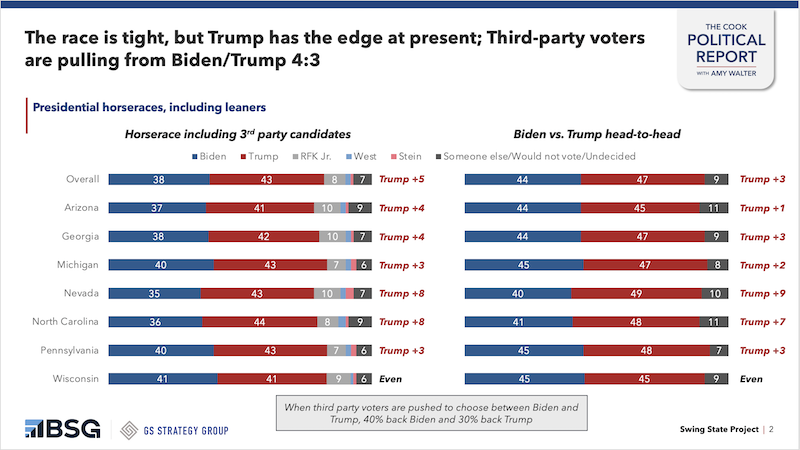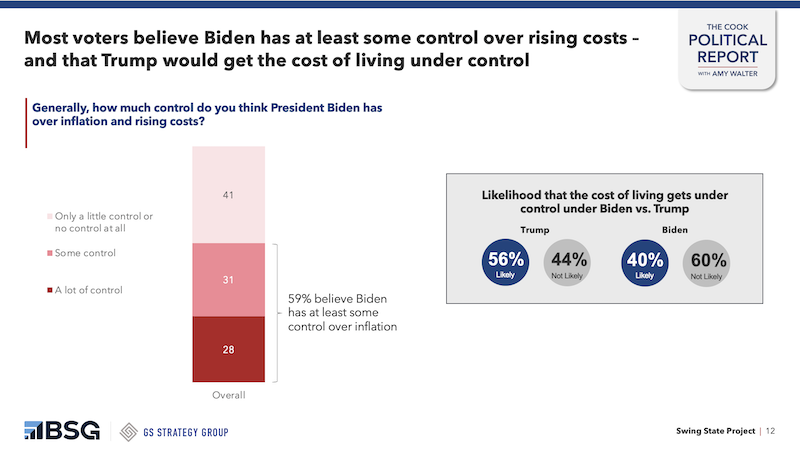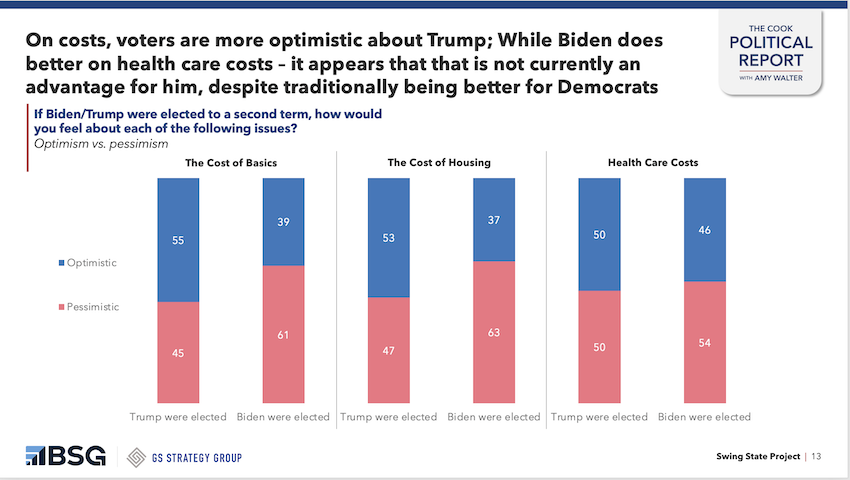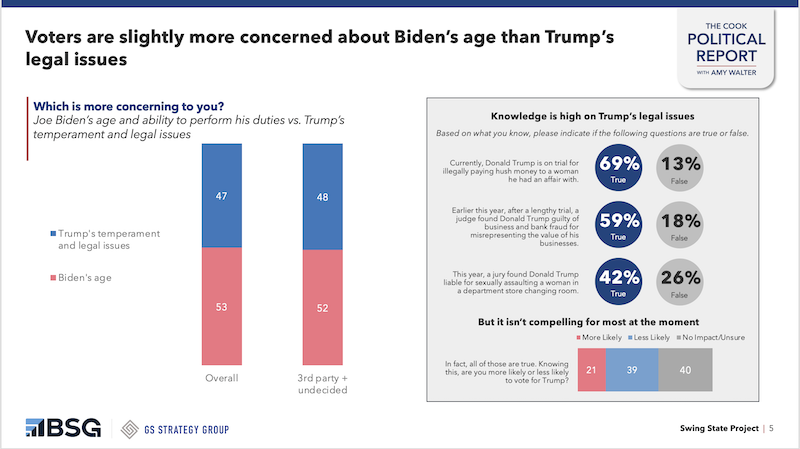
There are a lot of unique and untested variables in this upcoming presidential election. It is the first race in more than 100 years between an incumbent and former incumbent president (both of whom would be the oldest ever to be inaugurated). It is the first to feature a major party nominee under multiple indictments. And it's the first presidential contest since the Supreme Court decision that overturned Roe v. Wade.
At this point, however, the defining issue for this contest is a more traditional one: the economy. “Right now, this election is about President Biden’s economic record and America’s economic future,” said GS Strategies President Greg Strimple. “When it comes to who voters trust to move the economy forward, Trump is in the driver’s seat.”
While abortion remains a strong issue for Democrats, Biden’s advantage on the issue isn’t strong enough to offset Trump’s overall strength on bringing down the cost of living.
“Voters clearly recognize the huge steps backward a Trump presidency might bring - they are pessimistic about what he could do to abortion rights, progress on climate change, and even failing to protect Medicare and Social Security. And yet, their economic frustrations are enough to override all that,” said Lindsay Vermeyen, Partner at BSG.
That is one of the big takeaways from the Swing State Project — a collaboration between the Cook Political Report, GS Strategy Group (a Republican polling firm), and BSG (a Democratic polling firm). The project surveyed 3,969 voters in seven battleground states from May 6 to May 13.
In the seven states combined, Trump leads Biden in a head-to-head matchup 47% to 44%. In a five-way ballot test that includes Robert F. Kennedy Jr., Green Party candidate Jill Stein, and independent Cornel West, Trump opened a larger lead: 43% to 38% for Biden and 8% for Kennedy Jr.
When looking at the individual states, Trump leads Biden in all but Wisconsin, where the two candidates are tied at 45% each. Trump’s leads in North Carolina (+7) and Nevada (+9) are the most robust. His leads in Arizona, Georgia, Michigan and Pennsylvania are much narrower, between one and three points. In 2020, Biden won every one of these states except North Carolina.

The Cost of Living Defines This Election
Many Democrats wonder why Biden isn’t getting more credit for an economy where unemployment is at record lows, the stock market is booming, and the post-COVID economic hangover has lifted. But those aren’t the measuring sticks that voters use to gauge the health of the economy. When asked what they thought the best markers of a strong economy were, few (6%) picked the stock market, only 13% picked low unemployment, and just 9% chose household income. Instead, a healthy majority (54%) said the cost of living was the best way to measure the strength of the economy. And, not surprisingly, 51% of voters also think that inflation is the “worst/weakest” part of the economy.
In other words, in the minds of voters, inflation is the engine — not the caboose — of the economy. Moreover, 59% of voters think that President Biden has control over inflation and rising costs. This helps explain why Biden’s approval rating on the economy is deeply underwater at -20 (40% approve to 60% disapprove). Meanwhile, perceptions of Trump’s handling of the economy when he was president, marked by low inflation but huge job losses from COVID, are overwhelmingly positive, with 62% approving of how he dealt with economic issues.

More ominously for Biden, 78% think it’s likely inflation will continue to be an issue during a second Biden term, and only 40% think he would be able to bring down the cost of goods. Voters are much more optimistic about Trump’s ability to bring down prices, with 56% saying that they think that Trump will be able to get the cost of living under control if he were elected to a second term.
Trump’s significant advantage over Biden on the issue of inflation, however, isn’t enough to give him an equally large overall lead in a head-to-head matchup.
That’s because not everyone who thinks Trump did or would do a better job on the economy is voting for him. Of the 56% who think Trump is likely to get inflation under control, 18% said they will vote for Biden over Trump.
Voters’ perceptions of Trump remain negative overall (52% unfavorable to 46% favorable) and pretty well-baked in, which creates something of a ceiling for his electoral support.
Even so, Trump’s perceived strength on the economy — and immigration — are enough to help offset his other liabilities, including abortion.

Overall, swing state voters are more optimistic about how Biden would handle abortion in a second term than Trump, by a 14-point margin. But, Trump’s advantage over Biden on issues like immigration and inflation is twice as large.
“The degree to which the cost of living is the biggest pain point for voters today cannot be overstated,” said BSG Partner Patrick Toomey, “I am haunted by the fact that more voters are currently backing Trump than feel confident that America will remain a democracy plain and simple if he becomes president again. There are significant numbers of voters who appear willing to risk the future of democracy because they believe Trump could help get costs down.”
Just 41% of voters said they were confident that “America would remain a democracy” if Trump won a second term, compared to 59% who said that Trump will either become a dictator, try and fail to become a dictator or didn’t know either way.
Voters More Worried About Biden Setting Economic Policy and Immigration Policy Than Trump Setting Abortion Policy
There is an argument to be made that Biden has yet to really define Trump on abortion. However, many voters already believe that Trump would be more restrictive on this issue should he win the election. Overall, 55% of voters in these battleground states think it’s at least somewhat likely that abortion would be banned nationwide under Trump and 52% think it is at least somewhat likely that he would try to outlaw contraceptives nationally. In other words, these voters aren’t naive about the risks to reproductive access, but many view rising costs as an overriding concern.
Among all voters, 73% ranked Inflation/Cost of Living as one of their top three issues, while 52% named Immigration/Border Security and 35% named Abortion/Reproductive Rights. Even among women, abortion ranked third (73% inflation, 48% immigration and 42% abortion) and among independents, abortion/reproductive rights ranked fourth.
When we asked voters which worried them more, Biden setting economic policy or Trump setting policy for abortion rights, 55% said they were more worried about Biden handling the economy than they were about Trump setting policy on abortion (45%). In fact, aside from Democrats, the only other demographic group that was more concerned about Trump setting abortion policy than Biden setting economic policy were college-educated women.
On immigration, a top issue for voters in these swing states, 53% of voters said they were more concerned about Biden setting immigration policy in a second term, while 47% were more concerned about Trump setting abortion policy.

Personal Liabilities
Both men enter this race as well-known entities with well-understood liabilities. But Biden’s “age and ability to complete his term” were seen as slightly more concerning than Trump’s “temperament and legal problems" by a 53% to 47% margin. In fact, a whopping 66% of voters think Biden won’t finish his term, including 48% of Democrats and 70% of independent voters.
Today, the Trump Campaign Theory of the Case Is Stronger Than Biden’s
The theory of the case from the Biden campaign is that despite frustrations with his handling of the economy, voters will re-elect the president once they appreciate the risks of Trump returning to office.
The Trump campaign argument is that voters fundamentally desire peace and prosperity and that Biden has failed on both those fronts.
Today, the “peace and prosperity” theory is winning out over “existential risks.” Swing state voters are pessimistic not just about the job Biden is doing today, but about his ability to make meaningful and positive change in a second term. Biden’s overall weak position, combined with voters’ deep worry about rising costs, is currently limiting his ability to make the case that Trump is the bigger risk.
Even so, the race is still close because both candidates’ personal weaknesses make it hard for them to leverage the issues that should benefit them.










Subscribe Today
Our subscribers have first access to individual race pages for each House, Senate and Governors race, which will include race ratings (each race is rated on a seven-point scale) and a narrative analysis pertaining to that race.